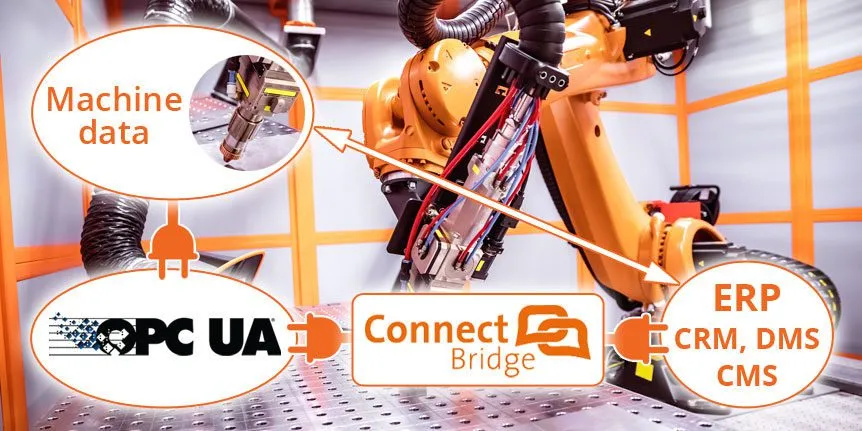By Richard F. Majer, flupo Systemtechnik e. U. (i. G.)
Everyone is talking about Industry 4.0
You hear about it at every trade show, there are entire exhibitions about it and whenever you hear a sales pitch for some fancy new machinery, you’re bound to get some high-gloss brochure praising the benefits of Industry 4.0 and Industrial Internet of Things. In this world, all your machines communicate with each other and the long-sought connection between factory floor and ERP (enterprise resource planning) environment, seems just within your grasp.
But as always, things tend to get murky when you get into the (somewhat gory) details. Typically, the larger machine vendors will supply you with their own Industry-4.0-connection software. For a hefty fee, of course. But if you ask questions about older machines (from the same vendor) or interoperability with other manufacturers, the typical salesperson will start mumbling something along the lines "yeah, maybe…; not officially supported, but might work; will be added in a future release." A rather unsatisfying situation, if you ask me.
Let’s have a look at a more specific example
Take a small company in the area of sheet metal production. Depending on its specific needs, it might have a small number of laser-cutting and/or punching machines, (bending) presses and maybe some robotic (laser) welding stations. While there are manufacturers that could supply this entire machine fleet, there’s a big likelihood that the machines will be from different vendors. And considering the average lifespan of the more robust machine types (e. g. bending presses), a considerable amount will be from the pre-Industry-4.0 era. And there, the promised dream of an out-of-the-box vertical integration between factory floor and ERP starts to crumble…
A starting point might be to buy every manufacturers solution and then build interfaces between them and your ERP solution. But this adds a huge layer of complexity in your company, as such a solution will take a considerable amount of time to implement and to maintain. There’s also the fact that, judging from past experiences in this sector, the software products will reach their respective end-of-life much sooner than the machines themselves. And there’s of course the price tag attached to the software and its maintenance contract. Not to mention the fact that some vendors offer cloud-only solutions which – in my humble opinion – just opens an entirely different can of worms. The cloud and its IT security are outside your control. And what about protecting your own and your clients‘ intellectual property?
There is a ray of light in the dark in the form of OPC UA
OPC UA is an easy to use standard supported by most modern equipment out-of-the-box (although still often unlocked only for an additional fee, which is something I’d really like to see change), this might be all you really need as a small company. Since your machine-to-middleware-interfaces usually need to be engineered only once (as typically, your machine control software will not be substantially changed during its lifetime), a custom-tailored low-maintenance solution is possible. With the advent of middleware solutions that "speak" OPC UA (like Connecting Software’s Connect Bridge), that mask the remaining complexity of the OPC UA stack for the developer and thereby reduce the amount of specialized M2M-communication knowledge needed, such solutions could even be realized by small IT departments (quite possibly even by your one-man-show IT department often found in SMEs). There are caveats, of course. Differently constructed address spaces, improper implementations (the author was able to crash a safety PLC (sic!) with OPC UA requests) all show that there is still some work to be done on the side of manufacturers.
Still, OPC UA seems to be the best way - and to some extent the only way at this point in time - to go forward if you're looking for vertical integration in a small business environment that allows you to realize your own solution, custom-tailored to your specific needs (and not those needs some marketing department thinks or wants you to have) while avoiding vendor or cloud lock-in, and keeping your data and your IP within your sole control.

About the author
Richard Majer is founder and CEO of flupo Systemtechnik e. U., a newly founded company specializing in industrial IT and automation technology for SMEs. He worked as a researcher in applied high-power laser production technology for the last 6 years and also served as CIO of his family’s sheet metal processing company for more than a decade.
How flupo uses the OPC UA Connector
Flupo is using Connect Bridge and the OPC UA Connector for integrating industrial machines with their business software.
Connect Bridge allows flupo to create robust interfaces between its own solutions and complex Microsoft products (e.g. Office 365, SharePoint, Dynamics365(CRM)) without the need for insider knowledge about these software systems and their APIs.
It is a pragmatic way to realize the “Industrial Internet of Things”(IoT) and Industry 4.0. Get started fast with first results in just a few hours; and quickly scale up to large environments.
About Connect Bridge and OPC UA Connector
Connect Bridge brings together business software and industrial machines in a super easy way.
Use ONE language to connect YOUR software or program with more than 30 business software applications and standard OPC UA supported devices like PLC, Robots, Machinery and Sensors.
With Connect Bridge you can access all your backend systems visualized like one big database but using the secured API´s of the vendors: Read and write to and from ERP/CRM systems, collaboration tools, Cloud storages, CMS systems, PLCs, sensors, and your machine park. To access all these data, you use the language that every IT student learns in his first year: SQL. Your first integration results will appear within a few hours! More than 12.000.000 Developers are ready to work with Connect Bridge within 3 hours! Use this power to increase your integration skills.
Save 90% of time and resources in your integration projects. No need for specialists or complex projects. No need to learn huge APIs that change every year.
There are seamless and unlimited integrations, like: Read production data from your robotics system, store it into an Excel file on Google Drive, create a service request in CRM, send an email to the technician, attach a link to a SharePoint dashboard which was created automatically from data your OPC UA server provided …
If you want to evaluate Connect Bridge and OPC UA Connector, please contact us for a free demo.

Comments 1
Thanks for sharing these useful information! This is really interesting information for me.